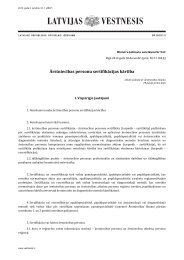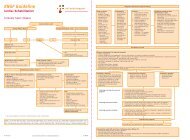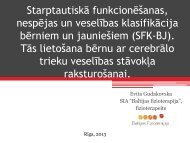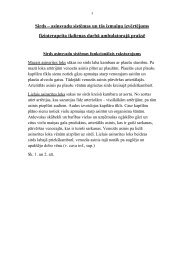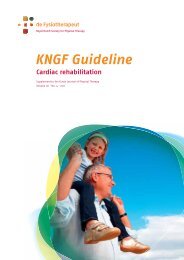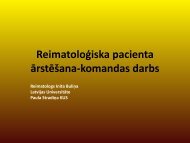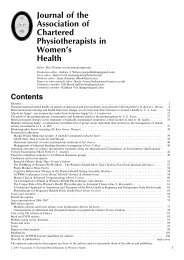You also want an ePaper? Increase the reach of your titles
YUMPU automatically turns print PDFs into web optimized ePapers that Google loves.
presents with the following clinical findings 78,141,293 :<br />
<strong>Low</strong> <strong>Back</strong> <strong>Pain</strong>: Clinical Practice Guidelines<br />
• Chronic, recurring low back pain that is commonly associated<br />
with referred lower extremity pain<br />
• Presence of 1 or more of the following:<br />
- <strong>Low</strong> back and/or low back–related lower extremity pain<br />
that worsens with sustained end-range movements or<br />
positions<br />
- Lumbar hypermobility with segmental motion<br />
assessment<br />
- Mobility deficits of the thorax and lumbopelvic/hip<br />
regions<br />
- Diminished trunk or pelvic region muscle strength and<br />
endurance<br />
- Movement coordination impairments while performing<br />
community/work-related recreational or occupational<br />
activities<br />
The ICD diagnosis of flatback syndrome, or lumbago<br />
due to displacement of intervertebral disc, and<br />
the associated ICF diagnosis of acute low back<br />
pain with related (referred) lower extremity pain are<br />
made with a reasonable level of certainty when the patient<br />
presents with the following clinical findings35,89,94,108,204 I<br />
:<br />
• <strong>Low</strong> back pain, commonly associated with referred buttock,<br />
thigh, or leg pain, that worsens with flexion activities<br />
and sitting<br />
• <strong>Low</strong> back and lower extremity pain that can be centralized<br />
and diminished with positioning, manual procedures, and/<br />
or repeated movements<br />
• Lateral trunk shift, reduced lumbar lordosis, limited lumbar<br />
extension mobility, and clinical findings associated<br />
with the subacute or chronic low back pain with movement<br />
coordination impairments category are commonly present<br />
The ICD diagnosis of lumbago with sciatica and the<br />
associated ICF diagnosis of acute low back pain<br />
with radiating pain are made with a reasonable<br />
level of certainty when the patient presents with the following<br />
clinical findings114 II<br />
:<br />
• Acute low back pain with associated radiating pain in the<br />
involved lower extremity<br />
• <strong>Low</strong>er extremity paresthesias, numbness, and weakness<br />
may be reported<br />
• Symptoms are reproduced or aggravated with initial to<br />
mid-range spinal mobility, lower limb tension/straight leg<br />
raising, and/or slump tests<br />
• Signs of nerve root involvement (sensory, strength, or reflex<br />
deficits) may be present<br />
It is common for the symptoms and impairments of body<br />
a16 | april 2012 | volume 42 | number 4 | journal of orthopaedic & sports physical therapy<br />
function in patients who have acute low back pain with radiating<br />
pain to also be present in patients who have acute<br />
low back pain with related (referred) lower extremity<br />
pain.<br />
The ICD diagnosis of lumbago with sciatica and<br />
the associated ICF diagnosis of subacute low back<br />
pain with radiating pain are made with a reasonable<br />
level of certainty when the patient presents with the following<br />
clinical findings35,65,120 II<br />
:<br />
• Subacute, recurring, mid-back and/or low back pain with<br />
associated radiating pain and potential sensory, strength,<br />
or reflex deficits in the involved lower extremity<br />
• Symptoms are reproduced or aggravated with mid-range<br />
and worsen with end-range lower-limb nerve tension/<br />
straight leg raising and/or slump tests<br />
The ICD diagnosis of lumbago with sciatica and the<br />
associated ICF diagnosis of chronic low back pain<br />
with radiating pain are made with a reasonable<br />
level of certainty when the patient presents with the following<br />
clinical findings65,121 III<br />
:<br />
• Chronic, recurring, mid-back and/or low back pain with<br />
associated radiating pain and potential sensory, strength,<br />
or reflex deficits in the involved lower extremity<br />
• Symptoms are reproduced or aggravated with sustained<br />
end-range lower-limb nerve tension/straight leg raise and/<br />
or slump tests<br />
The ICD diagnosis of low back pain/low back<br />
strain/lumbago and the associated ICF diagnosis<br />
of acute or subacute low back pain with related<br />
cognitive or affective tendencies are made with a reasonable<br />
level of certainty when the patient presents with the following<br />
clinical findings112,124,136,183,318 I<br />
:<br />
• Acute or subacute low back and/or low back–related lower<br />
extremity pain<br />
• Presence of 1 or more of the following:<br />
- Two positive responses to Primary Care Evaluation of<br />
Mental Disorders for depressive symptoms<br />
- High scores on the Fear-Avoidance Beliefs Questionnaire<br />
and behavior consistent with an individual who<br />
has excessive anxiety or fear<br />
- High scores on the <strong>Pain</strong> Catastrophizing Scale and cognitive<br />
processes consistent with individuals with high helplessness,<br />
rumination, or pessimism about low back pain<br />
I<br />
The ICD diagnosis of low back pain/low back<br />
strain/lumbago and the associated ICF diagnosis of<br />
chronic low back pain with related generalized



